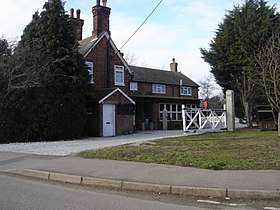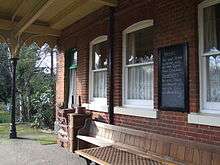Heacham railway station
Heacham was a railway station which served the seaside resort of Heacham in Norfolk, England. Opened in 1862, the station became a junction where services left the King's Lynn to Hunstanton line for Wells on the West Norfolk Junction Railway, which opened in 1866.[2] The station closed with the Hunstanton line in 1969.
| Heacham | |
|---|---|
 Main station building in 2010. | |
| Location | |
| Place | Heacham |
| Area | King's Lynn and West Norfolk, Norfolk |
| Grid reference | TF668375 |
| Operations | |
| Pre-grouping | Lynn & Hunstanton Railway Great Eastern Railway |
| Post-grouping | London and North Eastern Railway Eastern Region of British Railways |
| Platforms | 3 |
| History | |
| 3 October 1862 | Opened |
| 5 May 1969 | Closed[1] |
| Disused railway stations in the United Kingdom | |
| Closed railway stations in Britain A B C D–F G H–J K–L M–O P–R S T–V W–Z | |
History
The station, about a mile (1.6 km) to the west of Heacham village, was intended to tap a thriving holiday market which had developed in the 19th century. A favourite resort of Queen Alexandra, the village attracted large numbers of caravans and chalets to its shingly foreshore.[3] The Lynn and Hunstanton Railway proved an immediate success, and encouraged the construction of a second line, the West Norfolk Junction Railway from Heacham to Wells, which opened in 1866, thereby making Heacham a junction station.[4]

Services to Wells started and terminated in a bay platform to the east of the station, while trains to Hunstanton and King's Lynn departed from the two through platforms. The station was rebuilt at least twice, with the Great Eastern Railway adding platform canopies, a turntable and improving the platform buildings.[5] More substantial modifications were carried out by the London and North Eastern Railway in 1937 as Heacham had by then become a significant holiday destination, and it was necessary to extend the passing loop to accommodate 13-coach trains. A lattice girder footbridge linked the platforms, while a signal box was situated on the down side. Arriving passengers could find lodgings for the night in the nearby West Norfolk hotel.[6] From 1960 to 1961, the station was allocated a camping coach converted from a Pullman car, which was fitted with a full kitchen, two sleeping compartments and a room with two single beds, there were two allocated from 1962 to 1965.[7][8]
The post-war boom experienced by the King's Lynn to Hunstanton line was not felt on the West Norfolk Junction Railway, where inconveniently sited stations contributed to the declining passenger traffic. Passenger services from Wells were withdrawn from 31 May 1952, but the line remained open to freight until the North Sea flood of 1953, when the track between Wells and Holkham was so severely damaged that British Rail considered it not worth repairing and the line was closed completely between these two places. The King's Lynn to Hunstanton line survived 17 more years before itself closing in 1969 amid falling traffic and service cutbacks.[9]
| Preceding station | Disused railways | Following station | ||
|---|---|---|---|---|
| Snettisham Line and station closed |
British Rail Eastern Region King's Lynn to Hunstanton branch |
Hunstanton Line and station closed | ||
| Terminus | British Rail Eastern Region Heacham to Wells line |
Sedgeford Line and station closed |
Present day
The station buildings mostly survived, and as from 1993, were converted into holiday accommodation, with a camping and caravan site on the old trackbed.[10] The owners of the site acquired a British Railways Mark 1 first class carriage from the Battlefield Line Railway in 2006, converting it into further holiday accommodation.[11] The old signal box survived for many years, but was removed to make way for a housing estate.[12]
References
- Butt, R.V.J. (1995). The Directory of Railway Stations, Patrick Stephens Ltd, Sparkford, ISBN 1-85260-508-1, p. 116.
- Oppitz, Leslie (1999). Lost Railways of East Anglia (Lost Railways). Newbury, Berkshire: Countryside Books. p. 16. ISBN 1-85306-595-1.
- Jenkins, S.C. (1987). The Lynn & Hunstanton Railway and the West Norfolk Branch. Headington, Oxford: Oakwood Press. p. 94. ISBN 0-85361-330-3.
- Joby, R. S. (1985). Forgotten Railways: Vol. 7 East Anglia. Newton Abbott, Devon: David & Charles. p. 47. ISBN 0-946537-25-9.
- Jenkins, S.C., op. cit. p. 95.
- Jenkins, S.C., op. cit. p. 96.
- "Pullman Cars as Camping Coaches". Railway Magazine. 107 (711): 449–450. July 1960.
- McRae, Andrew (1998). British Railways Camping Coach Holidays: A Tour of Britain in the 1950s and 1960s. Scenes from the Past: 30 (Part Two). Foxline. p. 50. ISBN 1-870119-53-3.
- Jenkins, S. C., op. cit., pp. 112–113.
- Jenkins, S. C., op. cit., p. 96.
- Heacham Online, "All Aboard for Heacham Station - and its Nov 2006!".
- Oppitz, L., op. cit., p. 17.